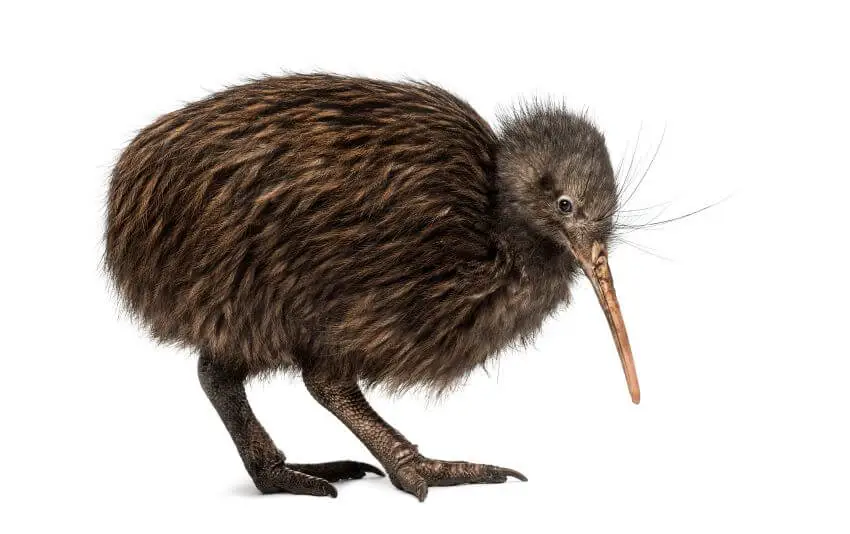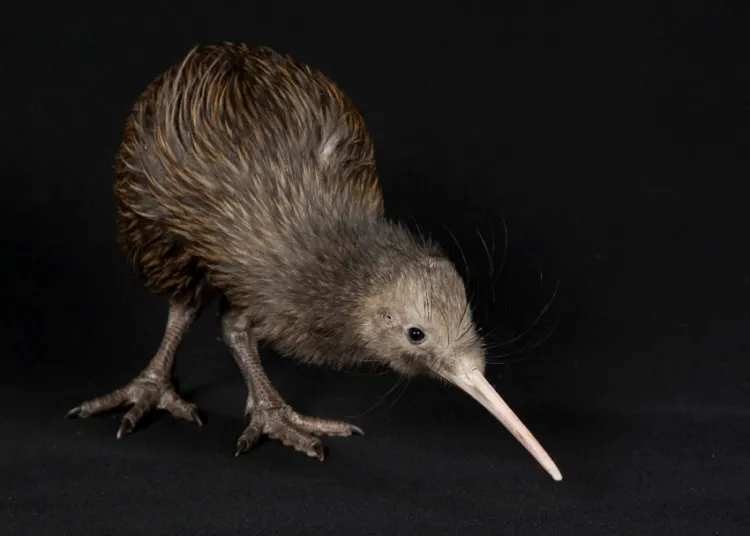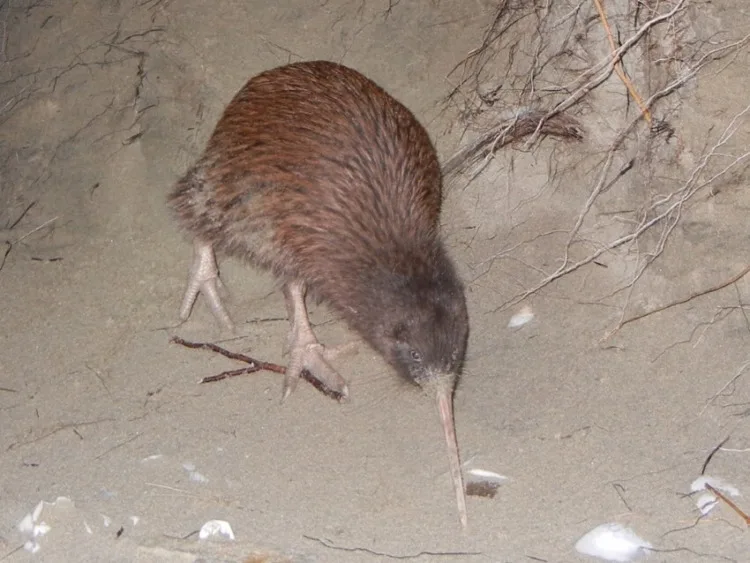Brown Kiwis or North Island Brown Kiwi (Apteryx mantelli) are found in the South Pacific, and they are one of the rarest birds on Earth. Brown Kiwi’s main predators are humans, which is why these bird species populations have significantly decreased over time.
- Status: Vulnerable
- Known as: Brown Kiwi, Common Kiwi.
- Estimated numbers left in the wild: 29,800 in two subspecies.
They live in New Zealand and Australia; Brown Kiwis can grow to be about 16 inches long with a wingspan of up to 4 feet.
Brown Kiwis mainly eat insects (including grasshoppers) and vegetation like flowers, nectar, fruit, berries, and leaves; North Island Brown Kiwi has feathers that act as insulation from cold weather. The brown coloration of its coat helps it blend into the forest environment where it lives among trees bark for camouflage.
Description

Brown Kiwi is the national bird of New Zealand; they are the third most popular bird in zoos behind chickens and eagles. North Island Brown Kiwi is very skittish birds by nature, and they easily get stressed when humans or other predators approach them.
There is an estimated 1-2 million Brown Kiwis that are found throughout New Zealand; these species are not currently endangered. Brown Kiwi’s can live up to 10-20 years in age. They have many predators that include cats, ferrets, dogs, and stoats among others that pose a threat to these birds’ populations.
Anatomy and Appearance
The brown kiwi is a sturdy flightless bird covered in almost hair-like feathers, which lack the barbules found on most birds’ feathers. This gives these birds a decidedly shaggy look. The feathers are reddish-brown, though they are also streaked.
They have brown plumage with some white markings on their chest and around their eyes. These bird species are approximately the size of a chicken or even smaller than a chicken, and they have a long beak that is perfect for tearing into the bark to get at insects.
The kiwi has no tail and measures between 45 and 55 centimeters in length. Males are smaller than females, weighing 1.6 to 2.8 kilograms compared to the females’ 2.1 to 3.9 kilograms. The kiwi’s beak is long, slim, and curves slightly downwards.
See Related: Amsterdam Albatross
Location
New Zealand is the brown kiwi’s principal home, with an additional population on Stewart Island. The North Island Brown Kiwi lives in various habitats, from coastal sand dunes to tussock grasslands, native forests, and subalpine scrub. These bird species were located on the Eastern north island of New Zealand.
Brown Kiwi Habitat
Many of these species prefer to live in swampy areas with tall, dense vegetation. These bird species are primarily nocturnal- they sleep during the day and come out at night to hunt for food. They have a diet of snails, earthworms, insects, grubs, and other small animals.
These birds also swallow stones to help their gizzard grind up the animals it eats.
They are typically shy creatures that are difficult to spot in their natural habitat which is mostly in lowland sites or scrub like farmland. They are primarily active after sunset but will go looking for food during the day if necessary.
Brown Kiwi Diet and Nutrition
These birds are solitary birds most of the time, roosting in low vegetation and a species emerging at night to eat insects. Grubs and worms are found underground by smell – the kiwi’s nostrils are at the tip of its beak, allowing it to scent this quarry more easily.
They also eat many other things found in their habitat, however, including seeds and fruits like berries. Crayfish, frogs, beetles, and eels are also taken when the opportunity offers.
These shy birds may not have been nocturnal before the arrival of humans and the predators they introduced, though this is not certain. They check leaf litter in finding foods to eat.
Brown Kiwi Mating Habits
The kiwi is a very long-lived bird, and one generation may be anywhere from 30 to 50 years, though reproduction is now believed to be somewhat faster.
They are monogamous, and a male and females remain together for decades once bonded. They use their loud nocturnal calls to keep in touch and share a burrow periodically during the breeding season.
One huge egg that weighs 25% as much as the female is produced in each season.
The male incubates this egg for up to 92 days, and the young bird is soon able to fend for itself after hatching, though it often stays near its parents until the next breeding season. These bird species hold the world record for laying the largest bird egg relative to their body size.
These species make their nests in hollow logs, burrow dug, or several burrows, and they lay their eggs in these nests. They are monogamous birds, meaning they mate with one partner for life.
Males are responsible for incubating the eggs, in a hollow log and they also take care of the young chicks once they hatch. Their chicks are able to leave the nest and fend for themselves when they are about two months old.
This species of kiwi is a rare bird, meaning it can’t be found in most places. North Island Brown Kiwi is born after about six weeks incubated by the mom, usually in a nest. Brown Kiwi’s are not typically born with many feathers, but their fully grown feathers will have a brown color to them.
Role in the Ecosystems
These species cover many aspects of the ecosystem. These animals are omnivores, which means that kiwis eat plants and other animals.
They are an important part of the ecosystem because they help to keep insect populations in check. They were also important seed dispersal species, which is good because they will go to different areas of their native forests to find food.
It is a flightless bird that is found in the South Pacific. If this creature became extinct, it would be a major loss to the ecosystem. They help to disperse seeds and eat insects; without them, the environment would be overrun with pests and there would be a decrease in plant diversity.
These animals are also important in maintaining soil health. So, if we lose the North Island Brown Kiwi, we lose more than just an interesting animal-we lose essential members of our ecosystem that play a crucial role in keeping everything balanced.
Relationship With Humans
There is a relationship between Brown Kiwis and humans that is very important to know about. They are found in the South Pacific and because of their rarity, they became one of the most endangered animals around the world.
These birds are seen as attractive animals to hunt because of their trophy-like feathers but hunted more than any other animal on the planet because they are capable of breeding for long periods of time. These bird populations have significantly decreased over time because of this.
Brown Kiwi Facts
Here are the interesting and fun facts you need to know about Brown Kiwi Facts
- They are an animal that lives in the South Pacific and they are one of the rarest animals in the world.
- These species iwis live with humans and Brown Kiwi’s numbers have decreased because humans kill Brown Kiwis.
- They love to eat leaves and bugs.
- They iwis are only found in the South Pacific region.
- The species’ main predators are mammalian predators mainly humans, which is why their populations have significantly decreased over time.
- They also spend their time on the ground looking for food rather than living in trees or bushes.
See Related: How Do Animals Adapt to Their Environment?
Conservation Status

The Brown Kiwi is one of the most vulnerable birds in the world; according to the IUCN, there are only 1,000-5,000 remaining in the wild.
Brown Kiwis are found in the South Pacific and their main predators are humans. Their populations have decreased significantly over time due to hunting and habitat loss.
There are a few organizations that are working to conserve these bird species populations, including the New Zealand Department of Conservation and Forest Lifeforce Foundation.
Threats
The overwhelmingly central source of danger to the brown kiwi today is the activity of introduced predators. Different predators present risks to different stages of the birds’ life cycle. Eggs are eaten by stoats and brush-tailed possums, while juveniles and kiwi chicks are preyed upon by cats.
North Island Brown Kiwi has a few main predators, the most significant of which are humans. They are hunted for their meat and feathers, which has contributed to their decline in population numbers. Other predators of these kiwi species include stoats, ferrets, cats, dogs, and weasels.
Dogs and ferrets can kill adult birds and do so in those areas where they are present. Populations not exposed to these risks are more stable than those where predation is a risk.
Fortunately, the direct human activity itself is having little impact on the kiwi’s survival. Habitat loss has slowed to the point where it is not believed to present any hazard to these small, rotund birds. Humans seldom interact directly with the birds, and such encounters are likely to be peaceful.
See Related: Extinction vs. Threatened vs. Extinct Species
Conservation efforts
Government conservation efforts and non-profit organizations alike are being used to help preserve the kiwi for the future. Control and culling of predators are naturally central to most of these efforts.
Another conservation approach is Operation Nest Egg, which involves taking eggs and sub-adults out of the wild to help kiwi chicks survive and keeping them until the kiwis are large enough to be safe from most of the introduced predators. This method seems to be paying dividends in a rising kiwi population in the Haast area.
Other conservation efforts:
- Brown Kiwis are vulnerable because of human predators. These new birds should be protected in the wild in North Island and should have more kiwi zoos to help increase their population.
- These bird species should be added to no-kill policies nationwide, as well as being incorporated into the animal law curriculum for schools to teach what it means to protect animals like Brown kiwis.
- Because it has less than 1,000 individuals left in the world, more money is required to assist with conservation efforts.
See Related: Fascinating facts About Conservation
Organizations
Kiwis for Kiwi
Kiwis for Kiwi is a newly founded fundraising and advocacy organization formed in October 2012 to support different kiwi conservation projects throughout New Zealand.
Whakatane Kiwi Trust
The Whakatane Kiwi Trust funds the Whakatane Kiwi Project in New Zealand to protect the Northern brown kiwi. Funding goes towards predator control, breeding programs, mammalian pest control programs, and awareness projects.
Others
These species were also under the care of various organizations such as the Smithsonian’s National Zoo and Conservation Biology Institute. It is where in Smithsonian’s National Zoo the species is protected as well as Conservation Biology Institute helps in researching about these kiwi species.
See Related: Best Wildlife Conservation Jobs
Final Thoughts

Brown Kiwis are one of the rarest birds in the world that is currently vulnerable; there are only less than 1,000 of their population remaining. These species like to eat fruit and insects. They also spend their time on the ground looking for food rather than living in trees or bushes.
The Brown Kiwi is one of the most vulnerable birds in the world; according to IUCN, there are only 1,000-5,000 of these species of kiwi left in this wild. North Island Brown Kiwi populations have decreased significantly over time due to hunting and habitat loss.
FAQ
What is Brown kiwi?
Brown Kiwi is the North Island Brown Kiwi or Brown kiwi (Apteryx mantelli). They are exclusively native to New Zealand and are currently classified as a vulnerable species.
They are considered a sister taxon to all other Apterygiformes, or three-fingered bird species in which they have lost the use of one digit on each limb due to progressive reduction from their forelimbs.
Why are Brown kiwis vulnerable?
Brown Kiwis are vulnerable because they’re a rare bird, living in the South Pacific with less than 1,000 left in the world. They have been hunted extensively by humans and their natural predators have also contributed to these new birds’ numbers dwindling over time.
For every ten Brown kiwis born, there are facing 50 of their population that will die before adulthood!
Only 500 of these birds exist due to human intervention like hunting for feathers for Nazi adornment (feather boas), which has caused them to be at the brink of extinction.
Their habitat is small and many other animals live on it, including cats or owls who could easily kill one of these species.
Are Brown kiwis endangered or extinct?
North Island Brown Kiwi or brown kiwi is currently considered to be vulnerable animals. They have the main predator which is humans, and because these species populations have increased over time, they could potentially become extinct in the future if humans keep hunting them.
Other Species Profile
Related Resources
